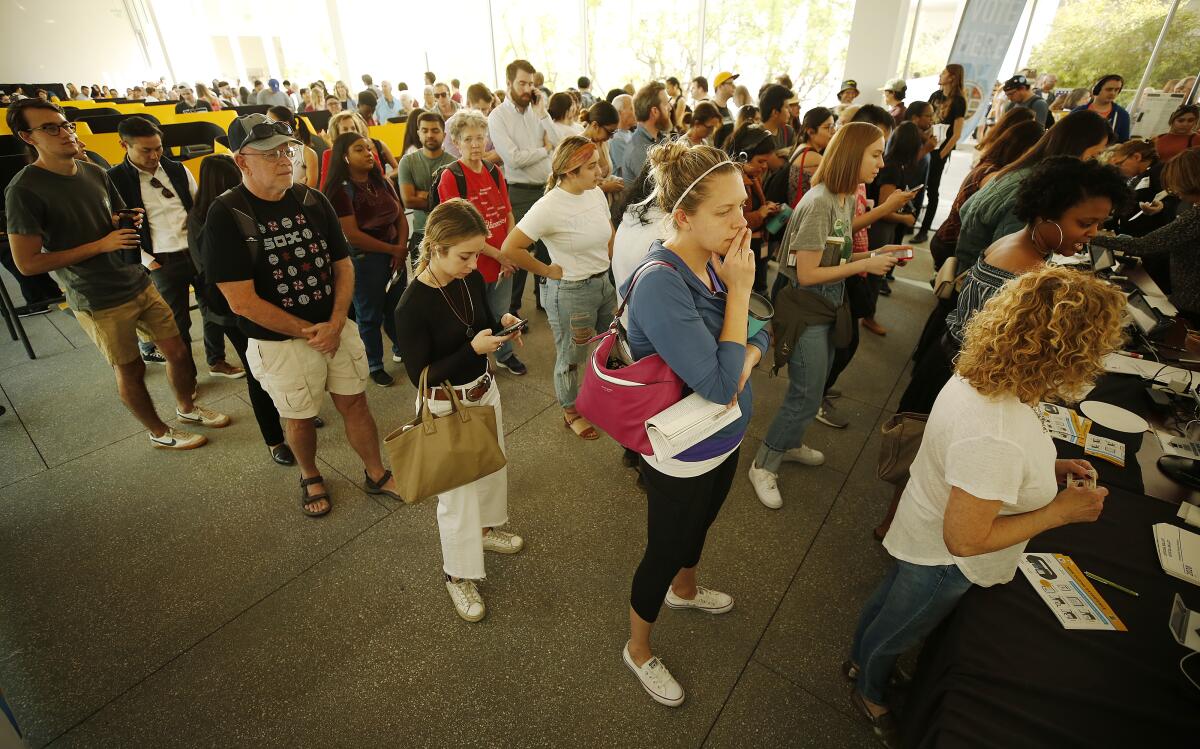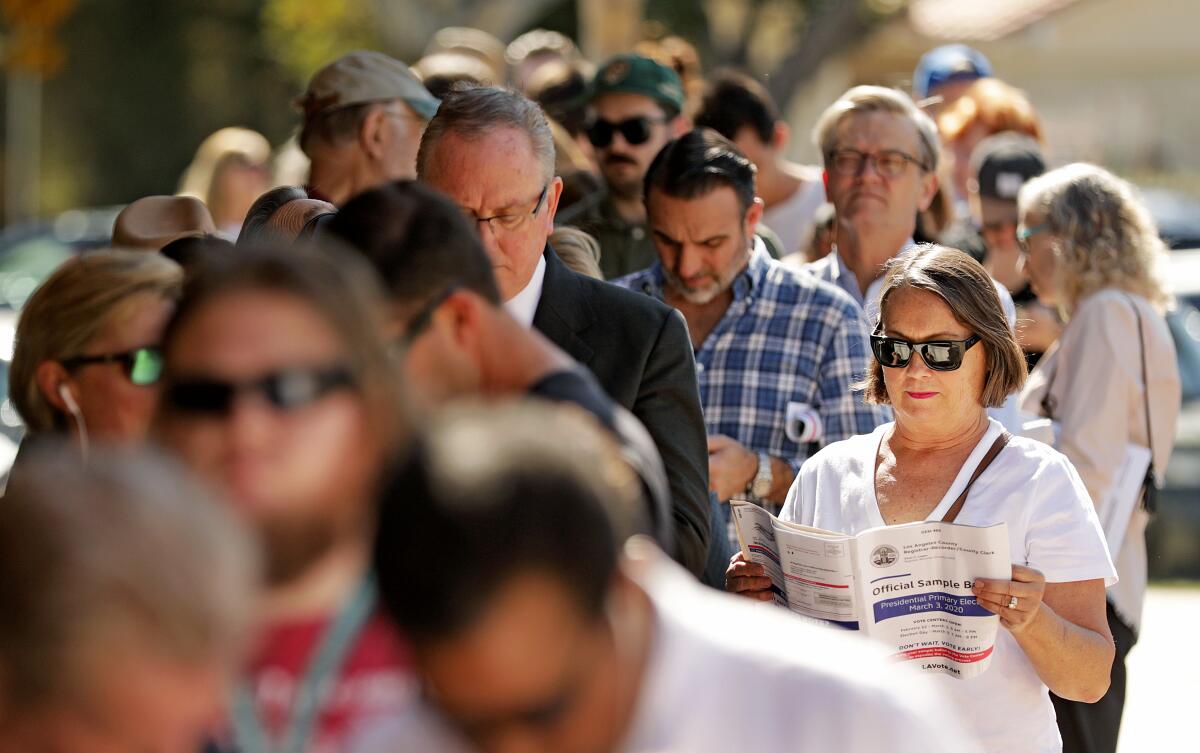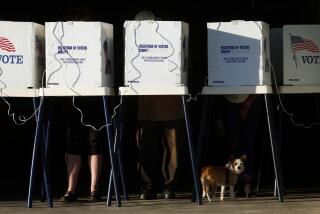L.A. County supervisors want answers to widespread voting problems

- Share via
Inadequate staffing, poor communications and balky technology turned election day in Los Angeles County into an anxious quagmire for many voters, whose complaints triggered calls Wednesday by one member of the Board of Supervisors for a “forensic autopsy” on what went wrong.
Voters reported waiting four hours and longer in some locations to cast their ballots. Some bounced from one polling place to the next, searching in vain for shorter lines. At one polling station, a worker said she wept in frustration while desperate voters scratched out their choices on write-in ballots — written in languages they did not speak.
“This is a disgrace,” one voter, who did not leave a name, complained to The Times. He added that the electronic check-in system was “nothing but an unholy mess.”
The messy outcome was a painful comedown for the county supervisors and elections chief Dean Logan, who invested $300 million in the effort after prior elections left votes uncounted and voters missing from the official rolls.

Officials had pledged that the electronic Voting Solutions for All People, or VSAP, system would be easier, more transparent and more secure. They expressed no serious reservations before Tuesday’s election, which included state and local races and the presidential primary.
Supervisor Janice Hahn introduced a motion at a Board of Supervisors meeting Wednesday ordering voting officials to report back within 45 days on the excessive wait times and staffing and technical problems. The motion also demands that officials come up with ways to solve the voting problems before the Nov. 3 general election.
The board is expected to vote on Hahn’s motion next week. At Wednesday’s meeting, the supervisors acknowledged the polling center problems but also suggested there were issues because many people voted on the same day.
“Many, many things went well; I wish more people had voted before yesterday,” said Supervisor Sheila Kuehl. “It took me six minutes on Sunday.”
“It was a new system, yes. We spent a lot of money on it,” Hahn said Wednesday. “But I really want to get to the bottom of some of the problems that did happen yesterday and see if they are fixable, of course, before November.”
It was unclear how much voter turnout affected the breakdowns. The county reported Wednesday morning that it had counted 1,137,023 ballots, or 20.62% of the county’s eligible registered voters. Of the total, 485,631 were vote-by-mail ballots, and 651,392 were cast at voting centers. But an untold number of ballots remained to be tallied, and county vote tabulations sometimes drag on for a week or more.
New vote centers that opened 10 days before election day were part of a revamped system that consolidated roughly 4,500 voting locations into 978 vote centers in neighborhoods stretching from Lancaster to Long Beach. Logan, the county registrar-recorder and clerk, acknowledged that the flow of voters overwhelmed vote centers in high-density areas such as downtown Los Angeles.
“Those locations were too small, and we didn’t have enough people to support them,” Logan told The Times. “The volume began to spin and there just wasn’t a way to catch up.”
Late on election night, Logan said the county also may have overestimated how many voters would use a new early voting period.
“That resulted in a significant amount of voters turning out on election day,” he said.
Complaints from voters and poll workers centered on two choke points in the new system.
The first came when voters tried to check in. Poll workers used electronic tablets to look up voter registration information, but as crowds swelled, the devices, called ePollbooks, stalled in attempts to sync with the county’s voter database.
“They never mentioned the syncing thing in training,” said Daniel Thwing, a worker at one west San Fernando Valley vote center. “The bottleneck was the sign-up [tablets]. Key presses wouldn’t do anything and then suddenly they would load everything all at once.”
Emily Dibiny, a worker at a center east of UCLA, said that even voters who brought in registration paperwork, complete with computer QR codes, did not appear in the electronic voter rolls.
“The scanner couldn’t read their registered personal info,” said Dibiny, who first lodged her complaints on Twitter. “We had to register people as new voters even though they lived at the same address for years, even if they voted in 2018.”
When registration could not be confirmed, voters were told they would have to cast provisional ballots, uncounted until a postelection check of the voter’s eligibility.
Some voters and poll workers said the problems seemed exacerbated because poll workers lacked technical savvy. Thwing, a computer science major at Pierce College, said he quickly figured out how to use the tablets to sign in voters. But he said some older workers struggled during an eight-hour training.
“It was going to be the blind leading the blind,” said Thwing, 22.
The second bottleneck occurred when voters tried to finish voting. Many did not understand that they had to get the touch-screen computer to print out a ballot, reinsert it into the machine after verifying selections and then press a final button to cast the ballot.
Thinking they had cast their votes, many voters walked away from the machines prematurely. By the time election workers chased them down, the machines might have been taken over by another voter. That led to further delays for voters who couldn’t submit their printout and instead had to cast provisional ballots.
The county’s election plan was unlike any other in California when it came to worst-case scenarios. While other counties deployed backup ballot printers, Los Angeles used only the touch-screen machines for printouts.
In January, Secretary of State Alex Padilla insisted on changes in L.A. County’s election plan before the new system would be cleared for use. Among the changes — which included hardware changes to reduce paper jams and better security seals on ballot boxes — was a last-resort method for voters to cast a ballot if the machines failed.
L.A. County’s alternative required voters to write in the name of the candidate or ballot measure choice in every race.
At the Warner Avenue Elementary School vote center in Westwood, voters became so frustrated that they tore open a box of the write-in forms, Dibiny said.
“We ran out of the ballots in English and people were taking them in Spanish and Chinese and Farsi, even if they didn’t speak that language,” said Dibiny, a voice-over actress. “They weren’t going to wait for four hours. They just wanted to vote.”
Poll workers said they were badly outnumbered. Holly Gunderson described her 18-hour shift at the Hollywood Hotel as “gnarly” — only four people staffed the vote center, far fewer than the 10 poll workers who had been promised during her training. In the West Valley, Thwing said a dozen workers were expected at his location, but only four showed up.
The stress mounted through the day.
Dibiny arrived before 6 a.m. and worked past 10 p.m. Sympathetic voters brought cookies and granola bars to provide poll workers sustenance. But a pizza delivered for the workers was gobbled up by hungry voters.
Not all voters were sympathetic.
“People were yelling at me,” said Dibiny, 49. “I was exhausted. I was crying.”
Los Angeles County is no stranger to election snafus. In 2000, thousands of voters complained that they never got absentee ballots they applied for. In 2008, about 100,000 nonpartisan voters had their presidential primary ballots voided because a confusing ballot design caused many to neglect marking an extra bubble.
In 2016, the county moved to early voting, only to see voters respond with such enthusiasm that some waited up to four hours at half a dozen polling places set up the weekend before election day. And in 2018, 118,500 names were omitted from the eligible-voter rosters when the county’s election software was unable to process a formatting change in state voter data.
The county had a trial run of the new electronic voting system in a local and municipal election in November, which revealed paper jams and other glitches. Logan and his staff reported to the Board of Supervisors in December that the printers had been recalibrated: “The pilot [program] assisted the department in identifying and resolving issues that would not have been identified otherwise.”
More to Read
Sign up for Essential California
The most important California stories and recommendations in your inbox every morning.
You may occasionally receive promotional content from the Los Angeles Times.














